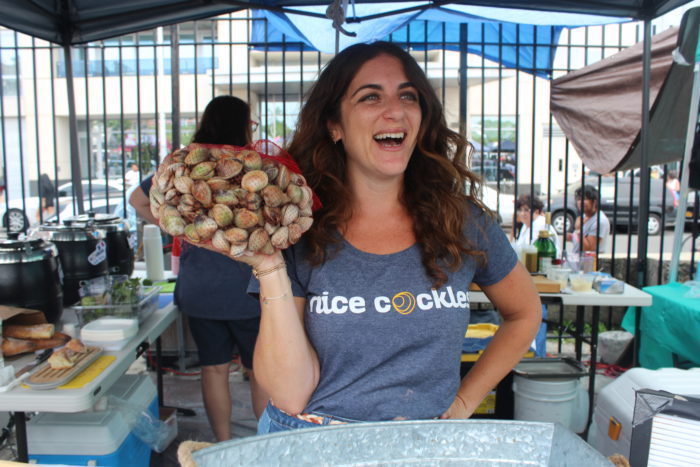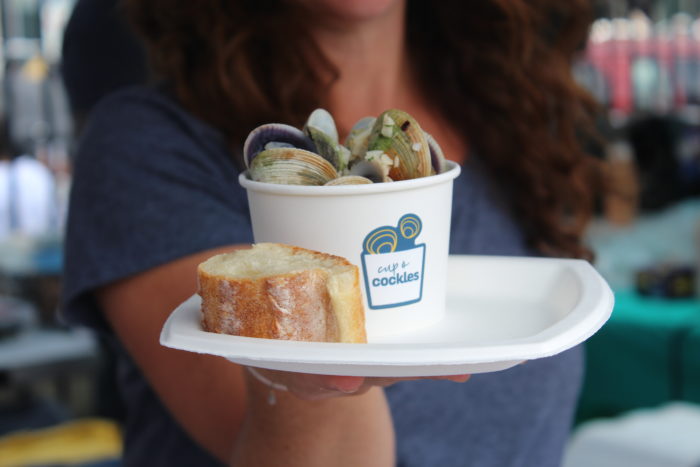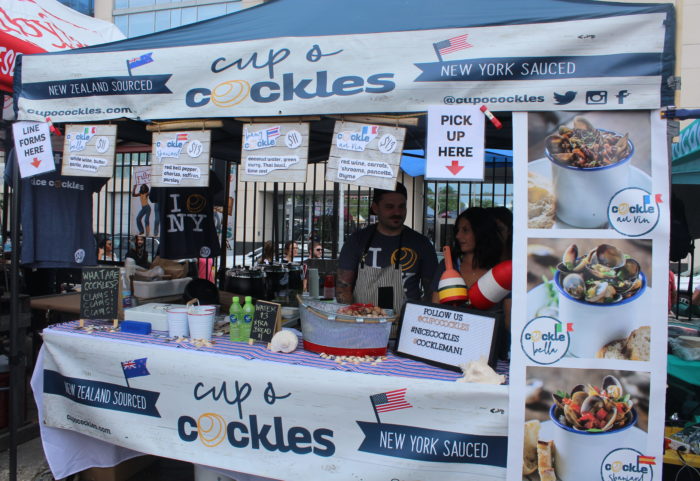A Delicious Day in the Life of a Smorgasburg Vendor
A neophyte food entrepreneur shares the ins and the outs of slinging clams at Brooklyn's giant outdoor market
Born into a family of seafood distributors, Lieberman decided to spin off a business of her own (Photos by Arden Phillips)
It’s 9:15 a.m. and I am hunched under a half-open canopy tent with my brother. The rain falls hard overhead—so hard that even if we had time to open the tent entirely before the gargantuan drops starting descending from the sky, it might not have withstood the force.
Around us, other vendors fasten the corners of their canvas tops, unplug extension chords and also duck for cover. Trucks and U-Hauls still pull into the lot on Williamsburg’s Kent Avenue, but windows remain up and doors remain closed.
Welcome to Smorgasburg—rain or shine.
The decision to set up and sell despite the dark skies and the iffy weather report is just one of the many vendors must make. As a virgin food entrepreneur selling street food—in this case, Cup o’ Cockles, or steamed Littleneck clams from New Zealand served with a variety of sauces—each decision I made was a first.

Cup o’ Cockles sells the clams in four different flavors of sauce at $11 to $13 per serving
Let’s start with my becoming a vendor at all. I’d had this cockle-mamie idea for a long time—eight years to be exact. My father is a third-generation seafood distributor, and cockles—a type of small clam that is generally served atop a heaping bowl of garlic and butter-drenched linguini—is one of the many products his 70-year-old company transports along the East coast. I got wind of how they eat them in England (cooked, but cold and served in a cup doused in nothing but vinegar), and after sampling them decided I could do better here in New York.
At the time, Smorgasburg was just getting going (as an offshoot of Brooklyn Flea) and I figured foodies would eat them up. But I was busy doing other things like pursuing a freelance writing career, moving to Paris and talking about the idea to anyone who’d listen. Fast forward to November 2017 and I finally decided to take action and apply for a coveted spot at the outdoor market, which sees up to 30,000 hungry gourmands at two locations each weekend.
I began by playing around with recipes for sauces that included punny names such as the Bang Cockle (a coconut-water-based broth with green curry) and the Cockle Spaniard (a saffron-infused red pepper and tomato sauce with chorizo), then whipped together a business proposal, uploaded a few photos to social-media platforms and launched a web site.
Shortly after submitting an application online, Smorg invited me for a tasting at their Crown Heights offices. For this real-life version of Top Chef, where a handful of “judges” sat around a large table asking questions about the concept while tasting the product, I enlisted the help of Mom and Dad, who we call the Cockle King. We left feeling hopeful, but also clueless, as they were pretty tight-lipped throughout. The only inkling that we’d done well was an occasional “mmmm” and a ton of empty cockle shells.
About three weeks later, I learned via email that I’d been accepted, and from that point on was more or less on my own to make it happen. High on my to-do list? Book a flight back New York for early June, employ a reliable chef, and enlist friends and family to volunteer in the kitchen and on site each week.

A Smorgasburg market typically has as many as 100 vendors and tens of thousands of customers
When opening day rolled around on June 30, it was hotter than hot. Damn hot! “Hottest things is my shorts. I could cook things in it. A little crotch pot cooking,” as Robin Williams said in Good Morning, Vietnam. Long before the market even opened at 11 a.m., I was covered in sweat, due to the physicality of essentially building a mini, 10′-by-10′ restaurant in all of two hours.
In our case, we have four folding tables, three soup warmers, a double induction burner, a giant cooler filled with 50 lbs. of cockles, bungee cords, extension cords, plastic ties, twist ties, duct tape, masking tape, double-sided tape and a whole lot of flair in the form of menu signage, branding signage and general cockle signage (a/k/a dried shells strewn about and tin-boat-shaped bucket of live bivalves).
And henceforth come a host of other decisions: Should we put up the flags? (’Cause there doesn’t seem to be much of a breeze today…) What about the tarp in the back to provide additional shade for chef? Both may seem like silly things to contemplate, but you try positioning a flag pole up on a 10-foot-high tent leg, opening a clamp, and then wrapping it all with duct tape under the glaring summer sun. Just getting the tape not to fold into itself is a feat alone.
I share all of this not to complain, but to enlighten. As we close up our booth for the season tomorrow, I can say without a doubt that it has been one of the most eye-opening and thrilling experiences I’ve ever undertaken. The ultimate highlight was getting to educate people about our product and watching them dive into those clams and, in many cases, come back for seconds.

Getting all that signage up and down is a physical workout for the team
But I went in knowing, well, not-knowing. The difference between an H15 food-service permit and an H25 permit? Guess I’ll find out. Liability and disability insurance? If you say so. Workers’ Comp, too? You got it. A food protection certificate? Sign me up. Sales tax? Mmmkay.
Not to mention the all-important recipe development and figuring out how to produce for large volumes, finding storage facilities, and arranging transportation methods and learning kitchen lingo like “cams” (large polycarbonate containers made by Cambro) and “finger spatula” (a spatula with a rubber top that’s as wide as, well, take a guess).
Back to that rain day—our first after a lucky six-week run of dry skies. If we didn’t go, we’d lose that day’s rent, not to mention the four-hour prep time on Thursday and ingredients we’d already bought and cooked. If we did go, we risked slow business and getting wet. On the other hand, several other vendors might bail, the weather could change, and we could make a killing due to the pared-down selection of vendors—hence our standing under a half-open tent and waiting it out.
Two weeks later, however, the weather was so bad at 7:30 a.m., when we first get going from our various positions (Jamaica, Queens, where we store our equipment and pick up the cockles, and Downtown Brooklyn, where I was staying), I called it quits before we even arrived on site. Then I spent the entire day second-guessing my decision whenever the sky turned the slightest shade of blue through otherwise ominous clouds.
I suspect that after we sell our final cup this weekend, Saturdays will forever have a similar tone; a feeling like I should be huddled under a 10-by-10 tent somewhere, slingin’ steamed clams. It may technically be a one-day-a-week, seasonal gig for me, but all that new knowledge now exists rain or shine.










